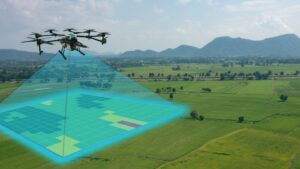Geographic Information System technology, also known by its abbreviated term GIS, is a technology many consider part of the industry 4.0 revolution. However, did you know that GIS has a long-established history and has changed from a concept to a science to a technological solution? It transitioned from a simple tool that mapped out important places to a robust and modern tool that mapped assets or required information in real-time. The purposes for which GIS was and is currently being used are wide-ranging. This article will outline the evolution of GIS technology.
It Started As A Concept
GIS was first documented in 1832 during the cholera outbreak in France by Charles Picquet, the French geographer who created a map. Resembling a modern-day heat map, it represented the cholera epidemiology in Paris, featuring 48 districts with different halftone colour gradients. This is perhaps the first spatial analysis in epidemiology.
A similar approach was documented in 1854 with the cholera outbreak in London, England. To ensure that infected areas were free of the public, John Snow, a British physician, wanted to map out the outbreak’s locations, water lines, properties and roads. This map became one of the most important documents that helped save the people in the country by mapping it; Snow discovered a pattern that allowed the scientific community to establish that cholera was not airborne but transmitted by water.
Although both of the above incidents represent the beginning of the spatial analysis, it depended on updating a sizeable physical map consistently for a long time. Individuals like Snow, however, did present GIS as a problem-solving tool, showing the potential it had if developed further.
With the concept introduced by Snow in 1960, research on quantitative and computational geography emerged. Michael Goodchild, from the National Center for Geographic Information and Analysis, took the lead to officially standardise research on GIS science topics, including spatial analysis and visualisation. This led to a significant development in geographic science, and the academic research and theory compiled laid the groundwork for GIS.
The Making of the First Computerised GIS System
Despite Snow being the first to make GIS a concept, the father of GIS is attributed to Roger Tomlinson. This could be because, until this time, mapping was solely based on paper. In 1963, Tomlinson made the first computerised GIS system for Canada (thereby calling it Canadian GIS/ CGIS) as the government commissioned him to create a manageable inventory of its natural resources. He designed a solution that could store and process enormous amounts of data, allowing Canadaalso to initiate the national land-use management program. The core feature was that CGIS used a layering approach to map handling. It also formed a national coordinate system, had separate file storage for attribute and locational information and infused data into the map by identifying their relations. Subsequently, the US Census Bureau adopted the core principles of GIS and digitalised consensus boundaries, roads and urban areas. It was also Tomlison that introduced the term ‘GIS’ into the world.
In the development of GIS during this period, three major technological advancements occurred in computer technology that contributed to GIS. This included mapping using line printers, upgrades in data storage and having a better processing power of mainframe computers. At the same time, the Ordnance Survey GB developed topographic mapping, which was used to simplify updating future map edits. In other words, they had the capability to convert data from digital scans into topologically coded map formats. Eventually, in 1971, the first OS large-scale map production was initiated.
The First Computer Mapping Software
In 1964/5, at Northwestern University, Howard T. Fisher developed the first prototype of the computer mapping software called SYMAP. Thereafter, in 1965, he established the Harvard Graduate School of Design’s Laboratory for Computer Graphics and Analytics. This became a leading research centre for spatial analysis and visualisation.
In 1969, Jack Dangermond and his wife founded a company called Environmental Systems Research Institute, Inc, known as ‘Esri’ for short. As an individual coming from a background in environmental science, landscape architecture and urban design, Mr Dangermond wanted to apply computer mapping to his field. To do so, he went to work in the laboratory for Computer Graphics at Harvard. It was here that ODYSSEY GIS was created, the first vector GIS.
Towards the late 1970s, developments were made in computer memory and graphic capabilities. This led to the creation of the first commercial GIS software.
GIS Entering the Market
In 1981, GIS officially went commercial. Esri played the dominant role in commercialising it as it improved its software tools. This occurred with the creation of ARC/INFO, which was the first commercial GIS product. From 1990 to 2010, much faster, cheaper and more powerful computers were being developed. Additionally, as digital mapping started to become readily available, GIS entered the market. As this was also a period of innovation and advancement in space with the introduction of earth observation satellites and remote sensing technology, GIS started to be infused with other powerful tools, leading to more GIS-based applications being developed. It thus became a solution that extended to a range of industries, including the education and the public sector.
Open Source GIS
After GIS was widely used in the market for over twenty years, open-source GIS emerged. As processors are now measured in gigahertz and GIS data storage in terabytes, GIS data has become more ubiquitous, making the technology even more accessible to other parts of the world. Even tools such as Landsat satellite imagery, LiDar data and TIGER (Topologically Integrated Geographic Encoding and Referencing) GIS data became accessible everywhere. Further, the ArcGIS repository stores enormous amounts of spatial data, allowing anyone to download them, do quality control and use them for their respective needs. This no longer became a technology restricted to a computer device. Instead, it was now on the web, the cloud and even a person’s mobile. Hence, every time a person uses a location-based facility on google or books an uber, it uses GIS.
GIS in 2023 and Beyond
According to a report by Global Market Insights 2024, the GIS market is predicted to grow to USD 9 billion by the end of 2024. The importance of GIS is only increasing by the day. With the introduction of AI, ML, and technologies such as the Internet of Things, everything is connected in real time. As geography becomes the underlying anchor that grounds the connection between technology, humans and Earth, GIS help us to make sense of, prioritise and take more intelligent decisions. The future of GIS, moreover, looks at infusing 3D to create more nuanced visualisations, provide location-based augmented reality applications, and help the development of self-driving cars by creating an effective navigation system and mapping indoor environments.
GIS Wields So Much Power
GIS is not simply a tool that records and maps out places for the intended purpose. It is an advanced analytical tool that assesses and recommends intelligent solutions that as more cost-effective, feasible and safe for all. While many industries can benefit from incorporating this technology, governments can guarantee ROI with a compact solution such as GIS that can automate checkups and ensure all assets function smoothly.







